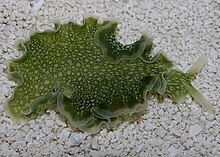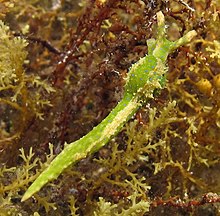
Back زقية اللسان Arabic زقية اللسان ARZ Sacoglossa Bulgarian Sacoglossa CEB Schlundsackschnecken German Sacoglossa Spanish Sacoglossa Basque کیسهزبانان Persian Pussikielikotilot Finnish Sacoglossa French
| Sacoglossa Temporal range:
| |
|---|---|

| |
| Elysia crispata, a shell-less species in the family Placobranchidae | |

| |
| Oxynoe viridis, a shelled sacoglossan in the family Oxynoidae | |
| Scientific classification | |
| Domain: | Eukaryota |
| Kingdom: | Animalia |
| Phylum: | Mollusca |
| Class: | Gastropoda |
| Infraclass: | Euthyneura |
| Superorder: | Sacoglossa H. von Ihering, 1876[2] |
| Diversity[3] | |
| 284 species | |
| Synonyms | |
|
Ascoglossa Bergh, 1876 | |
Sacoglossa are a superorder of small sea slugs and sea snails, marine gastropod mollusks that belong to the clade Heterobranchia known as sacoglossans. There are 284 valid species recognized within this superorder.[3] Sacoglossans live by ingesting the cellular contents of algae, hence they are sometimes called "sap-sucking sea slugs".[4] Some sacoglossans simply digest the fluid which they suck from the algae, but in some other species, the slugs sequester and use within their own tissues living chloroplasts from the algae they eat, a very unusual phenomenon known as kleptoplasty, for the "stolen" plastids.[5] This earns them the title of the "solar-powered sea slugs", and makes them unique among metazoan organisms, for otherwise kleptoplasty is known only among other euthyneurans and single-celled protists.[6]
The Sacoglossa are divided into two clades - the shelled families (Oxynoacea) and the shell-less families (Plakobranchacea).[7] The four families of shelled species are Cylindrobullidae, Volvatellidae, Oxynoidae, and Juliidae, the bivalved gastropods. The shell-less Plakobranchacea are grouped in six families, divided between two clades ("superfamilies"), the Plakobranchoidea and the Limapontioidea. All sacoglossans are distinguished from related groups by the presence of a single row of teeth on the radula. The teeth are adapted for the suctorial feeding habits of the group.[8]
- ^ Cite error: The named reference
Jensen1997was invoked but never defined (see the help page). - ^ Ihering H. v. (1876). "Versuch eines natürlichen Systemes der Mollusken". Jahrbücher der Deutschen Malakozoologischen Gesellschaft 3: 97-148. Sacoglossa is on the page 146.
- ^ a b Jensen, Kathe R. (November 2007). "Biogeography of the Sacoglossa (Mollusca, Opisthobranchia)" (PDF). Bonner zoologische Beiträge. 55 (3–4): 255–281. Archived from the original (PDF) on 5 October 2013.
- ^ Tan, Rina (December 2008). "Sap-sucking slugs". Wild Singapore. Retrieved 12 January 2010.
- ^ de Vries, Jan; Christa, Gregor; Gould, Sven B. (2014). "Plastid survival in the cytosol of animal cells". Trends in Plant Science. 19 (6): 347–350. doi:10.1016/j.tplants.2014.03.010. ISSN 1360-1385. PMID 24767983.
- ^ Händeler, K.; Grzymbowski, Y. P.; Krug, P. J.; Wägele, H. (2009). "Functional chloroplasts in metazoan cells - a unique evolutionary strategy in animal life". Frontiers in Zoology. 6: 28. doi:10.1186/1742-9994-6-28. PMC 2790442. PMID 19951407.
- ^ Handeler, K.; Grzymbowski, Y. P.; Krug, P. J.; Wagele, H. (2009). "Functional chloroplasts in metazoan cells - a unique evolutionary strategy in animal life". Front Zool. 6 (1): 28. doi:10.1186/1742-9994-6-28. PMC 2790442. PMID 19951407.
- ^ Barnes, Robert D. (1982). Invertebrate Zoology. Philadelphia, PA: Holt-Saunders International. p. 377. ISBN 0-03-056747-5.